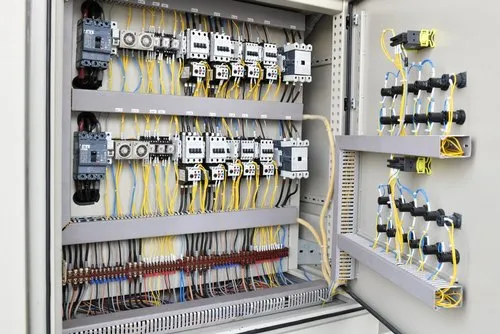Panels contributes energy distribution.

PLC-SCADA Panel

PLC-SCADA Panel
A PLC-SCADA Panel is an essential component in industrial automation systems, particularly in manufacturing and industrial processes. It combines two critical technologies: Programmable Logic Controllers (PLCs) and Supervisory Control and Data Acquisition (SCADA) systems. Here's an explanation of a PLC-SCADA Panel and its functions:
Programmable Logic Controller (PLC)
Control Logic: PLCs are industrial computers that execute control logic. They receive input signals from various sensors and devices, process the data, and generate output signals to control machinery and processes.
Reliability: PLCs are designed for high reliability in industrial environments. They are known for their ruggedness and ability to withstand harsh conditions.
Real-Time Control: PLCs operate in real-time, allowing for precise and time-critical control of processes and machines.
Programmability: PLCs are programmable, meaning their control logic can be customized to suit specific industrial applications.
Supervisory Control and Data Acquisition (SCADA)
Monitoring and Visualization: SCADA systems provide a graphical interface for monitoring industrial processes. They display real-time data, including the status of equipment, sensors, and process variables, on operator screens.
Data Acquisition: SCADA systems collect and store data from various PLCs and sensors, enabling operators to track historical performance, detect trends, and make informed decisions.
Alarming:SCADA systems generate alarms and notifications when processes deviate from set parameters or when issues occur, allowing operators to respond promptly to problems.
Remote Control:SCADA systems often offer remote control capabilities, enabling operators to adjust settings or intervene in processes from a central location.
PLC-SCADA Panel
A PLC-SCADA Panel is a control panel that integrates both PLC and SCADA components. It typically includes the following:
PLC Hardware: The panel houses the PLC controller and related components, such as input and output modules, communication modules, and power supplies.
SCADA Software:SCADA software is installed on a computer within the panel or a connected server. This software provides the visualization, data logging, alarming, and control capabilities.
HMI (Human-Machine Interface): The panel often includes an HMI, which is a touchscreen or interface device that allows operators to interact with the SCADA system. Operators can monitor processes, acknowledge alarms, and make adjustments through the HMI.
Communication Equipment: To connect the PLC and SCADA components, the panel contains communication equipment, such as Ethernet switches and communication interfaces.
Power Distribution: The panel also provides power distribution and protection for the included components.
Functions and Benefits of PLC-SCADA Panels
Real-Time Control: PLC-SCADA panels provide real-time control and monitoring of industrial processes, ensuring efficient and accurate operation.
Data Collection:They collect and store valuable data, which can be used for process optimization, maintenance, and compliance reporting.
Remote Access: Operators can access and control processes remotely, improving efficiency and reducing the need for on-site presence.
Efficient Troubleshooting: The combination of PLCs and SCADA allows for efficient troubleshooting and quick responses to issues.
PLC-SCADA Panels are widely used in various industries, including manufacturing, utilities, transportation, and more, to enhance process automation, improve efficiency, and ensure the reliability and safety of industrial operations.
Benefits of our Service
Mention how using medium voltage panels can have a positive impact on the environment through reduced energy waste.
-
-
Discuss potential cost savings.
-
Reduced downtime, predictive
-
Offer links to brochures, data sheets.

Service Quality
Our commitment to service quality make us the preferred choice in the industry.
Service Guarantee
Our service guarantee is a reflection of our confidence in the durability and performance of our panel boards.
